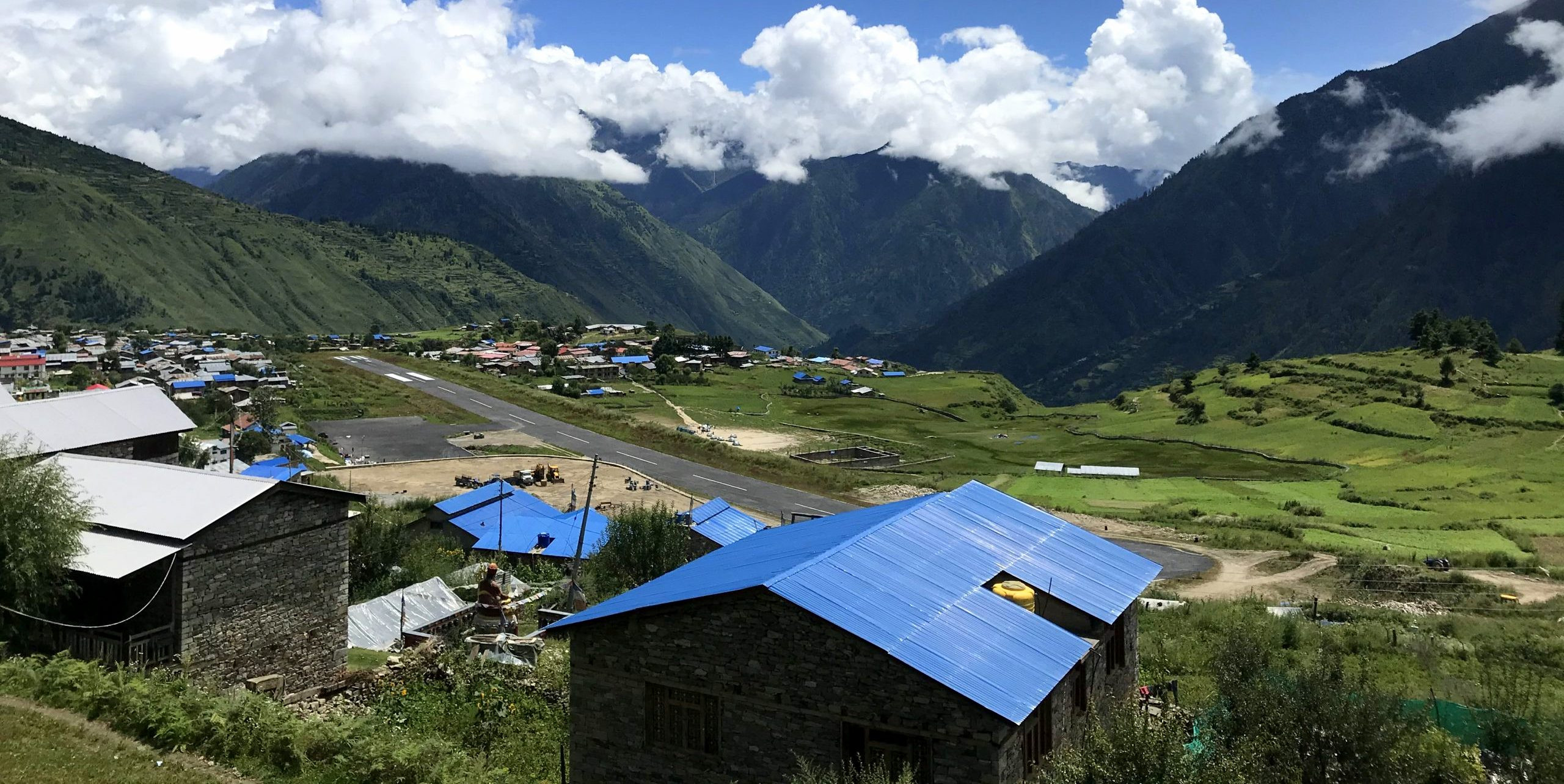Dolpo Region
The Dolpo Region, located in the upper reaches of Western Nepal, is one of the most remote and mesmerizing areas of the country. It offers a rare opportunity to experience landscapes and cultures that have remained largely untouched by the modern world. Here are some key highlights and insights into this incredible region:
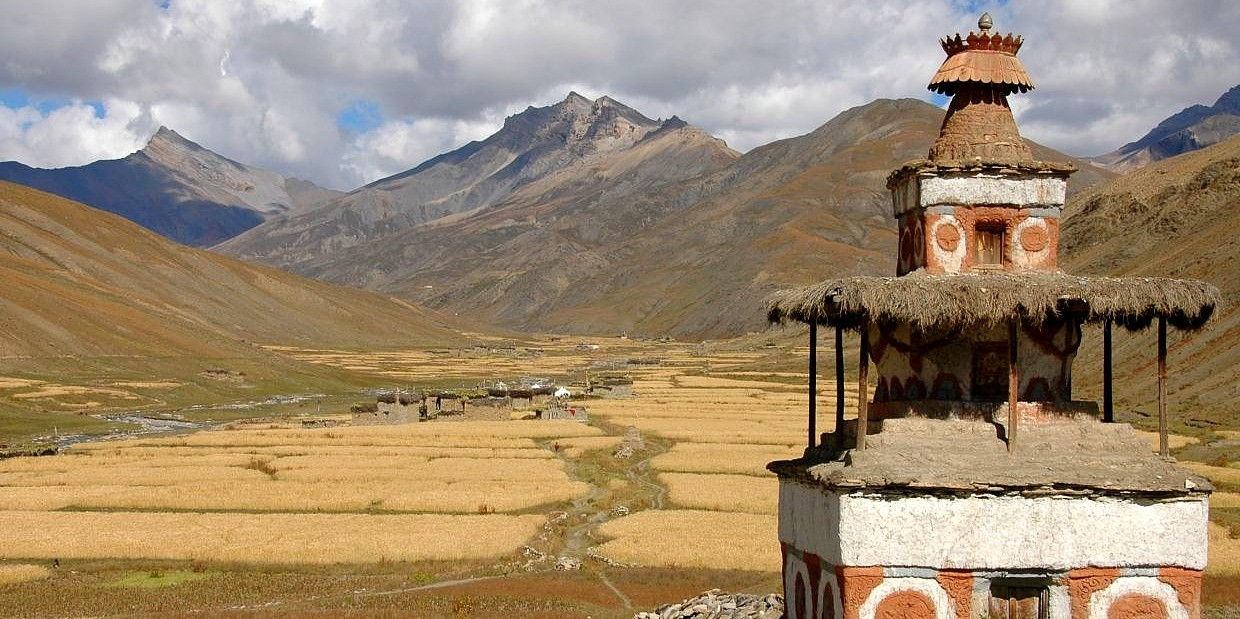
-
Geographical and Cultural Isolation: Dolpo is surrounded by high mountains including the Dhaulagiri range to the south-east. Its high altitude and rugged terrain have helped preserve its unique cultural identity, which is heavily influenced by Tibetan Buddhism. The region is so isolated that some areas are only accessible by foot or on horseback, adding to its mystique and appeal as a true escape from the modern world.
-
Shey Phoksundo National Park: Dolpo is home to Shey Phoksundo National Park, Nepal's largest national park. This park is known for its spectacular landscapes, including deep valleys, towering peaks, and the stunning Phoksundo Lake, renowned for its turquoise waters. The park is also a biodiversity hotspot, home to a variety of wildlife including the elusive snow leopard, blue sheep, and Himalayan tahr.
-
Shey Gompa and Tibetan Buddhism: One of the most iconic sites in Dolpo is Shey Gompa, which is often referred to as the spiritual heart of the region. Located at the base of Crystal Mountain, which is itself an important pilgrimage site, Shey Gompa is a centuries-old monastery known for its ancient Buddhist scrolls and artifacts. The region’s strong ties to Tibetan Buddhism can be seen in the daily lives of its people, who follow traditional practices and rituals that have been passed down through generations.
-
The Annual Yarchagumba Harvest: Dolpo also gains attention for the annual harvest of Yarchagumba (Cordyceps sinensis), a caterpillar-fungus highly prized in traditional Chinese medicine for its supposed health benefits. This rare fungus is one of the main sources of income for local families, bringing harvesters to the high meadows of Dolpo each year.
-
Trekking and Exploration: For trekkers, Dolpo offers an unparalleled adventure. The region's trails are less trodden compared to Nepal’s more popular routes, providing a more solitary and introspective trekking experience. The Upper Dolpo trek, which requires special permits due to its proximity to the Tibetan border, is particularly famous. It not only challenges trekkers physically but also rewards them with incredible views and a profound sense of peace.
-
Cultural Resilience and Challenges: Despite its beauty and cultural richness, Dolpo faces significant challenges. Its geographic isolation makes it difficult to access modern healthcare, education, and economic opportunities. The harsh environment also poses serious challenges to daily life, making sustainability a key concern for its inhabitants.
Visiting Dolpo is not just a journey into a physical wilderness but also a profound cultural exploration. For those looking to understand Nepal beyond its popular tourist spots, Dolpo represents an unparalleled opportunity to connect with a way of life that has stood the test of time amidst some of the most dramatic landscapes on Earth.
Manaslu Circuit
The Manaslu Circuit is one of the lesser-known treks in Nepal, often overshadowed by its more famous neighbors like the Annapurna Circuit. However, for those in search of a truly remote and authentic Himalayan experience, the Manaslu Circuit offers an exceptional journey through landscapes and cultures that have remained relatively untouched by the outside world.
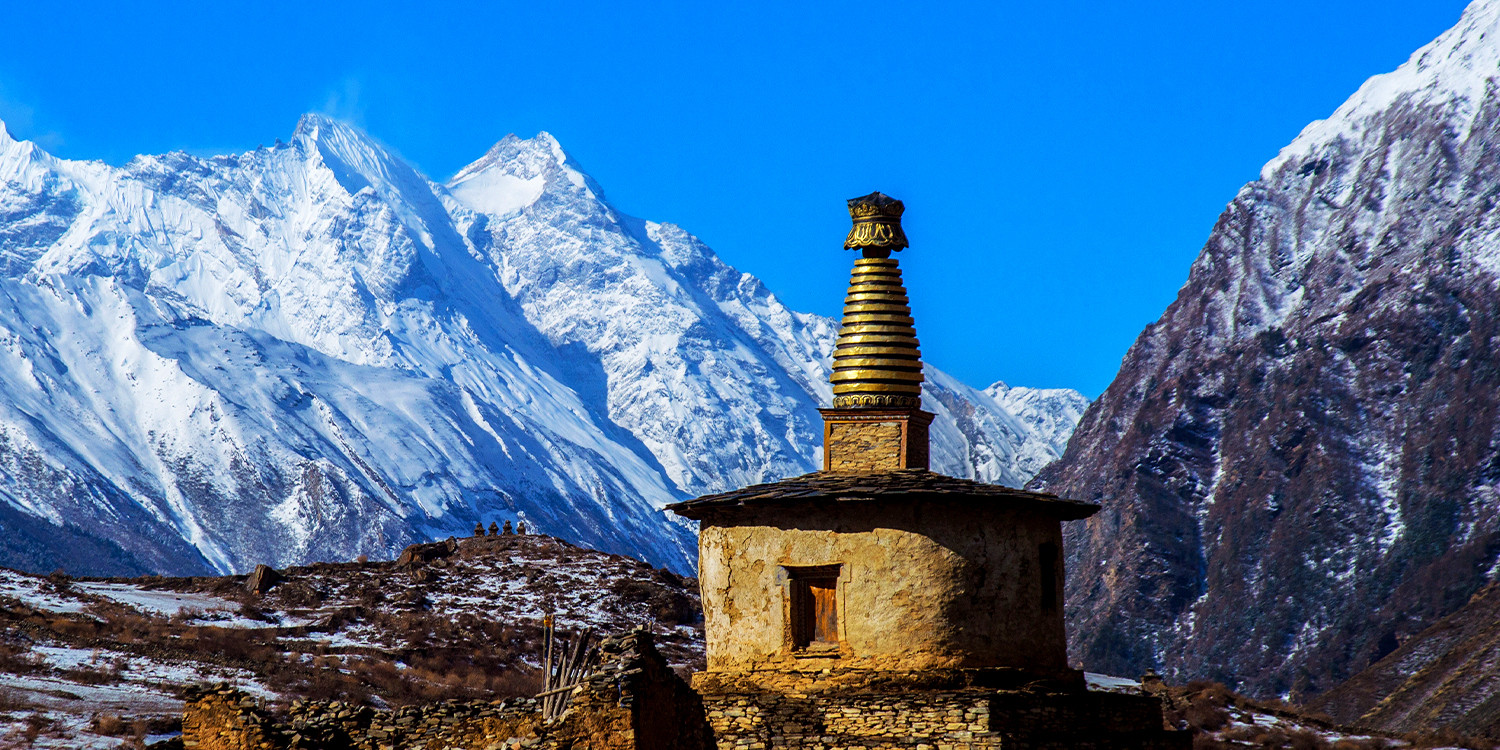
-
Geographic Setting: The trek circumnavigates Mount Manaslu, the world's eighth highest peak, standing at 8,163 meters (26,781 feet). The circuit traverses from tropical lowlands filled with lush forests up to arid high altitude zones, offering a dramatic contrast in ecosystems and scenery. The highest point of the trek is the Larkya La Pass, a breathtaking viewpoint at 5,106 meters (16,752 feet), which provides stunning panoramas of the Manaslu massif and surrounding peaks.
-
Cultural Diversity: The Manaslu Circuit passes through various ethnic communities, including Gurung, Magar, and Tibetan. These communities offer trekkers a glimpse into traditional Nepalese and Tibetan cultures. As the trail ascends, the influence of Tibetan Buddhism becomes more pronounced, visible in the architecture, monasteries, mani walls (stone walls inscribed with Buddhist prayers), and chortens that dot the landscape.
-
Trekking Experience: The trek typically takes about 14 to 20 days, depending on the chosen route and pace. Starting from the town of Arughat or Soti Khola, trekkers journey through Budhi Gandaki Valley, characterized by its deep river gorge, before climbing towards the higher and more arid regions. The route is less crowded compared to more popular treks, offering a more solitary and immersive experience.
-
Flora and Fauna: Throughout the trek, travelers encounter diverse ecosystems. The lower sections of the trek feature lush vegetation and are known for their rich biodiversity, including various species of birds and possibly even glimpses of larger wildlife like monkeys and leopards. As trekkers ascend, the landscape changes dramatically, with pine forests giving way to high-altitude tundra and rock.
-
Sustainable Trekking: Recently, there has been an increased focus on sustainable trekking practices in the Manaslu region. Local communities are involved in managing lodges and trail maintenance, ensuring that tourism benefits are distributed more equitably. This has helped improve local infrastructure and has increased awareness about preserving the natural and cultural heritage of the area.
-
Permits and Regulations: The Manaslu Circuit is located in a restricted area, requiring trekkers to obtain a special permit and to trek with a registered guide. This regulation helps manage the impact of tourism and maintains the exclusivity of the trekking experience.
For those willing to step off the beaten path and experience a part of the Himalayas that is both challenging and rewarding, the Manaslu Circuit offers an unforgettable adventure. Its combination of stunning natural beauty, cultural richness, and relative solitude makes it a standout trek in Nepal's vast repertoire of trails.
Kanchenjunga Base Camp
The Kanchenjunga Base Camp trek is an extraordinary journey to the foot of the world's third-highest mountain, Kanchenjunga, which stands at an impressive 8,586 meters (28,169 feet). This trek is not only renowned for its remote beauty and challenging routes but also for the unique cultural experiences it offers, making it a coveted adventure for serious trekkers seeking solitude and unspoiled nature.
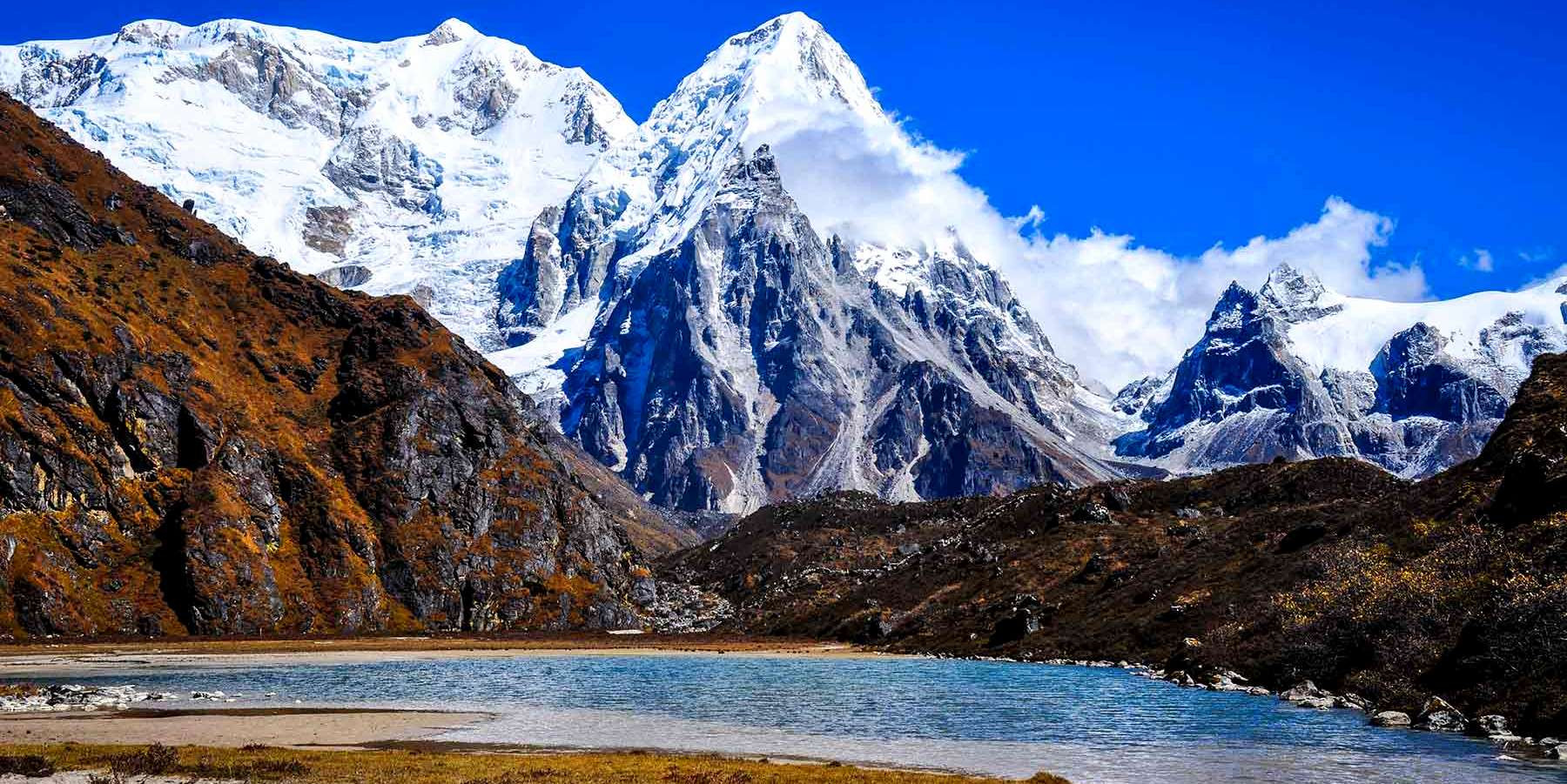
-
Geographic Splendor: Kanchenjunga is located in the far eastern part of Nepal, straddling the border with India. The trek to its base camp traverses some of the most stunning and varied landscapes in the Himalayas, from lush, tropical jungles and rhododendron forests to high-altitude deserts and massive glaciers. The trek provides spectacular views of the mighty Kanchenjunga massif, along with a range of other towering peaks.
-
Two Base Camps: The trek to Kanchenjunga is unique in that it can involve visiting both the South and North Base Camps, offering diverse perspectives of the mountain. The South Base Camp provides dramatic close-up views of the mountain's southern face, while the North Base Camp, often referred to as Pangpema, offers panoramic vistas of the northern face and the surrounding peaks.
-
Cultural Richness: The Kanchenjunga region is less frequented by tourists compared to other parts of Nepal, which has helped preserve its rich cultural heritage. Trekkers pass through traditional villages of the Limbu, Rai, Sherpa, and Tibetan communities, each offering a glimpse into their unique customs, rituals, and way of life. The hospitality and warmth of the local people add a profound depth to the trekking experience.
-
Biodiversity: The region is part of the Kanchenjunga Conservation Area, which spans over 2,035 square kilometers. This area is a biodiversity hotspot that includes a range of ecosystems and is home to diverse wildlife, including the snow leopard, Himalayan black bear, red panda, and many species of birds. The conservation efforts in the area help ensure that the natural environment remains as pristine as possible.
-
Trekking Challenges: The Kanchenjunga Base Camp trek is considered one of the more challenging treks in Nepal due to its remote location, high altitudes, and less developed trails. The trek typically lasts about three weeks, requiring good physical fitness and proper acclimatization. The isolation of the region means that trekkers must be well-prepared, often carrying more supplies and equipment than would be necessary on more popular treks.
-
Permits and Regulations: Like the Manaslu Circuit, the Kanchenjunga trek requires special permits due to its status as a restricted area. Trekkers must be part of an organized group and accompanied by a registered guide. These regulations help protect the natural and cultural integrity of the region.
Embarking on the Kanchenjunga Base Camp trek is a commitment to exploring one of the world’s most spectacular landscapes. It promises not just a physical journey through the Himalayas but also a deep cultural immersion into the lives of communities that have adapted to life at the edge of the sky. For the adventurous spirit, it offers an unmatched experience of exploration and discovery
Tsum Valley
Tsum Valley, often referred to as the "Hidden Valley," is a sacred Himalayan pilgrimage valley situated in northern Nepal. Known for its pristine beauty, rich culture, and spiritual significance, this valley offers a tranquil trekking experience unlike any other in Nepal, making it a perfect destination for those seeking peace and solitude.
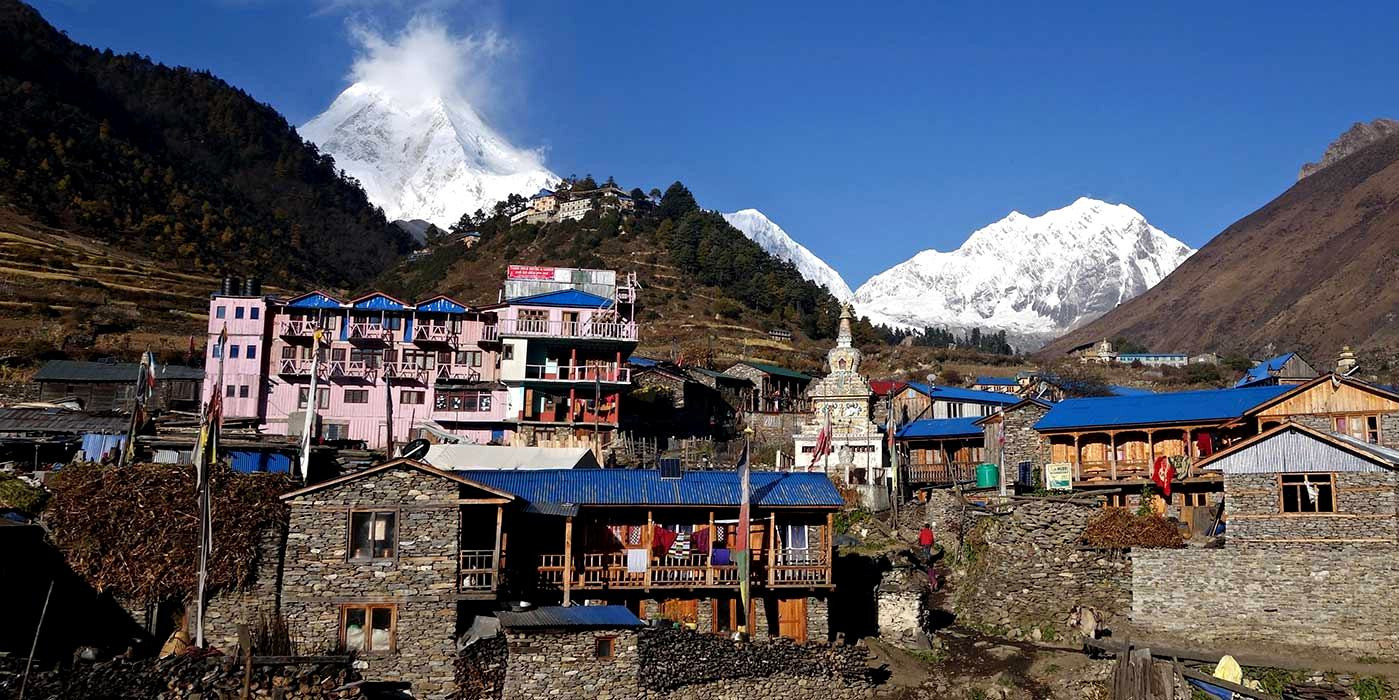
-
Geographical Isolation: Tsum Valley is strategically located against the majestic backdrop of the Ganesh Himal, Sringi Himal, and Boudha Himal ranges. This remote valley was virtually cut off from the rest of Nepal until recently, preserving a traditional way of life that has remained largely unchanged for centuries. The region's isolation has helped maintain a pristine environment with stunning landscapes that include deep gorges, terraced hillsides, and vibrant, dense forests.
-
Cultural Richness: The people of Tsum Valley are primarily of Tibetan origin and practice Buddhism. The valley is dotted with ancient monasteries, chortens, mani walls laden with prayers, and religious shrines that underline its spiritual importance. Among these, the Mu Gompa (monastery), located at an altitude of over 3,700 meters, and Rachen Gompa, are centers of pilgrimage and hold great religious significance to the local communities.
-
Unique Traditions and Practices: The culture in Tsum Valley is rich with unique rituals and practices. The local community observes distinct festivals, dances, and ceremonies, many of which are related to Buddhist ideology and lore. The practice of polyandry was once common in the region and traces of this tradition still linger, showcasing the valley’s unique approach to social structure and family life.
-
Biodiversity: Tsum Valley is part of the Tsum Valley conservation area, which aims to preserve the region's unique flora and fauna. The valley's varied elevational gradient supports a diverse range of biomes, including pine and rhododendron forests. Wildlife enthusiasts might spot Himalayan Tahrs, blue sheep, and if very lucky, the elusive snow leopard.
-
Trekking Experience: Trekking in Tsum Valley is considered moderate in difficulty, making it accessible to many trekkers. The trek typically starts and ends in Arughat or Soti Khola, similar to the Manaslu Circuit trek, and can take anywhere from two to three weeks. The journey is less commercialized and far less crowded than other popular treks in Nepal, offering a more serene and intimate experience.
-
Conservation Efforts: Conservation efforts in Tsum Valley are focused on sustainable tourism practices to protect the natural environment and cultural heritage of the area. These efforts ensure that economic benefits from tourism support the local communities without compromising their cultural values or the ecological balance.
Tsum Valley remains one of Nepal’s hidden treasures, providing a glimpse into ancient culture and untouched natural beauty. Its spiritual ambiance, combined with the dramatic Himalayan scenery and warm hospitality of the Tsumba people, offers a deeply fulfilling trekking experience for those looking to explore the spiritual and scenic realms of Nepal.
Upper Mustang
Upper Mustang, often referred to as the "Last Forbidden Kingdom," is a region in Nepal that stands out for its stark desert beauty and preserved Tibetan culture. This part of the Himalayas offers a landscape vastly different from the lush greenery typical of other areas in Nepal, presenting a unique blend of natural and cultural treasures that captivate the hearts of adventurers and cultural enthusiasts alike.
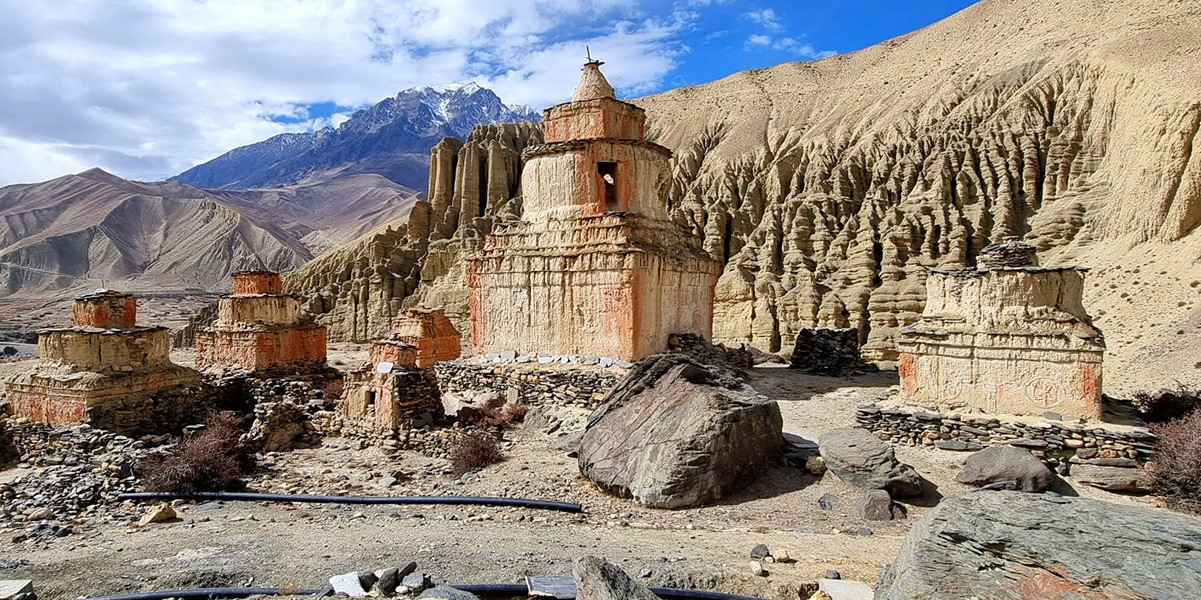
-
Geographic Uniqueness: Upper Mustang is located in the northern part of Nepal, close to the Tibetan border. The region is characterized by its arid, desert-like conditions, with a starkly beautiful landscape of barren hills, deep canyons, and unusual rock formations. This high-altitude desert is flanked by the towering peaks of the Annapurna and Dhaulagiri ranges.
-
Cultural Heritage: The culture of Upper Mustang is closely tied to Tibetan Buddhism, which is evident in the daily lives of its people, their festivals, and numerous ancient monasteries that dot the landscape. The region's capital, Lo Manthang, is a walled city that has served as the cultural and religious center of the area for centuries. Inside, visitors can explore old palaces and important religious sites, such as the Thubchen and Jampa monasteries, which hold significant artistic and historical value.
-
Historical Significance: Upper Mustang was a restricted demilitarized area until 1992, which helped preserve its unique culture and traditions from external influences. The area was once part of the Ngari kingdom, which was a vast empire in the Tibetan Plateau. Even today, the effects of its historical isolation are apparent in the preservation of the region's Tibetan heritage, making it a living museum of Tibetan culture.
-
Trekking Experience: Trekking in Upper Mustang is an experience like no other. It offers a rare opportunity to witness the lifestyle of true mountain people, who have adapted to surviving in one of the harshest environments on earth. The trek typically starts from Jomsom and unfolds along the scenic Kali Gandaki River Valley before gradually ascending to the high desert landscape of Lo Manthang.
-
Restricted Area Permit: Due to its sensitive location near the Tibetan border and its cultural uniqueness, the Nepalese government regulates travel to Upper Mustang. Travelers must obtain a special Restricted Area Permit, and trekking must be arranged through a registered trekking agency with a local guide. This regulation helps manage the impact of tourism and supports conservation efforts.
-
Conservation and Community Initiatives: Sustainable tourism practices are encouraged in Upper Mustang to help maintain the ecological balance and support local communities. Efforts are ongoing to ensure that tourism benefits the local economy without undermining the cultural heritage or the natural environment of the region.
Exploring the Upper Mustang is not just a physical journey but also a profound cultural immersion. The combination of its remote, dramatic landscapes and the resilience of its people offers a powerful experience that highlights the diversity and beauty of Nepal’s lesser-known regions. For those looking for an adventure that is both challenging and culturally enriching, Upper Mustang remains one of the most intriguing destinations in the Himalayas.
Rara Lake
Rara Lake, often hailed as the "Queen of Lakes," is a pristine and tranquil destination located in the remote northwestern part of Nepal. Nestled within the Rara National Park, it is the largest lake in Nepal and is renowned for its breathtaking beauty and serene surroundings, offering a distinct and peaceful experience away from the more frequented trekking routes.
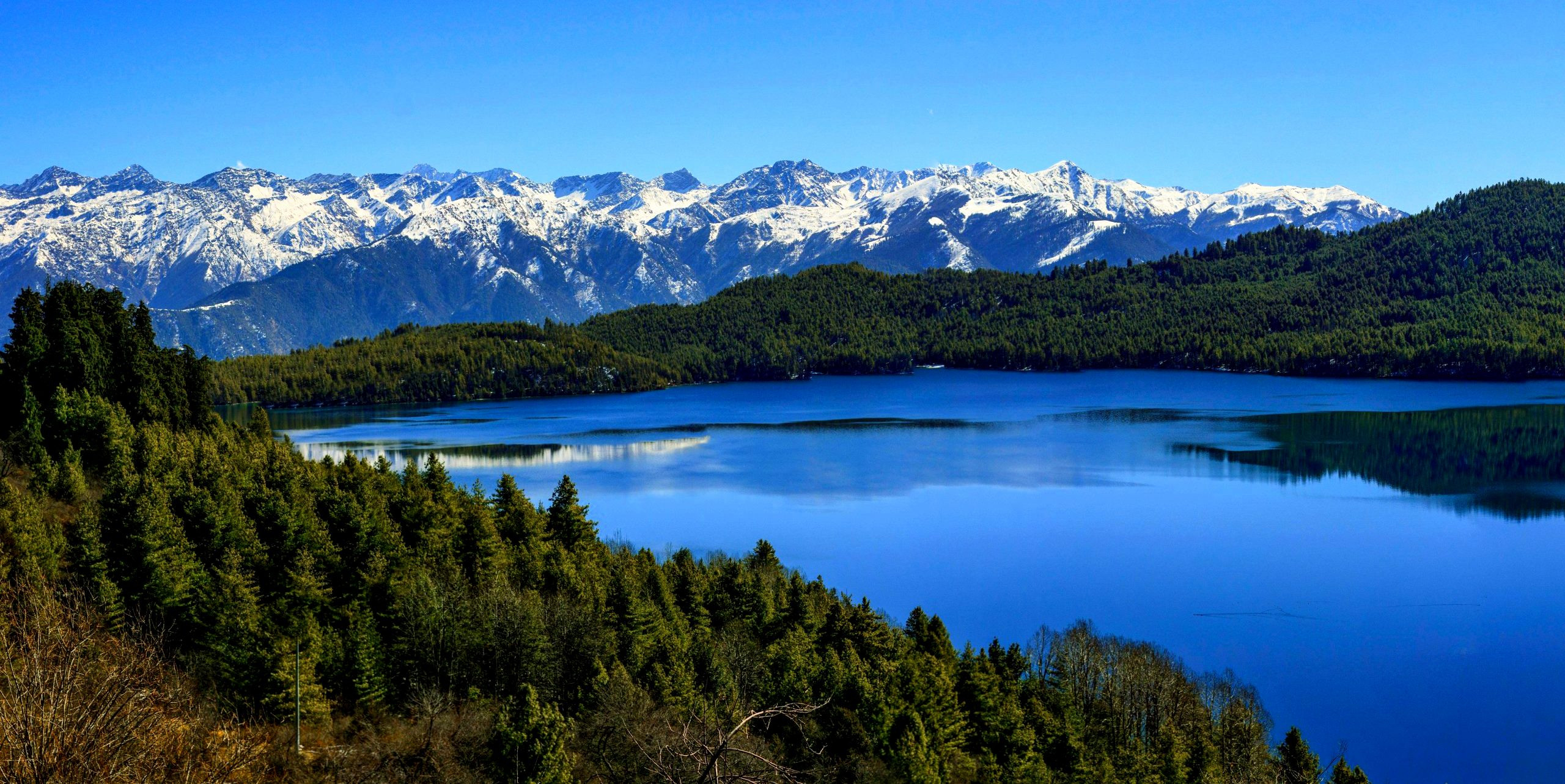
-
Geographic Setting: Rara Lake lies at an elevation of about 2,990 meters (9,810 feet) above sea level and covers an area of 10.8 square kilometers. Surrounded by alpine forests and set against the backdrop of the snow-capped Himalayas, the lake is a stunning natural wonder. The region experiences a range of climatic conditions, with winters bringing snow and summers offering a lush, vibrant landscape.
-
Rara National Park: The lake is the centerpiece of Rara National Park, which was established in 1976 to protect the unique flora and fauna of the area. The park spans an area of 106 square kilometers and is a haven for wildlife enthusiasts. It is home to species such as the Himalayan black bear, red panda, musk deer, and a variety of bird species including the Himalayan monal, Nepal’s national bird.
-
Trekking Experience: Trekking to Rara Lake is an adventure that offers tranquility and scenic beauty in abundance. The trek typically starts from Jumla or Mugu after a short flight from Kathmandu to either location. The route passes through remote villages and lush forests, providing a glimpse into the lives of the local communities and their traditional practices. The trek is considered moderate in difficulty, making it accessible to a wide range of fitness levels.
-
Cultural Insights: The area around Rara Lake is sparsely populated, with communities that have maintained a traditional lifestyle reliant on agriculture and livestock. The cultural practices of the region are influenced by both Hinduism and Buddhism, reflecting a blend of religious beliefs and traditions. Visiting Rara Lake provides an opportunity to experience the hospitality and simplicity of rural Nepalese life.
-
Ecotourism and Conservation: Rara Lake is a prime example of ecotourism in Nepal, with efforts focused on preserving the natural environment and promoting sustainable tourism practices. The beauty of the lake and its surroundings has led to increasing popularity, prompting initiatives to manage the impact of visitors. Conservation efforts are crucial to maintaining the biodiversity of the park and ensuring that tourism benefits the local communities without harming the ecosystem.
Rara Lake offers a serene escape into nature, ideal for those looking to unwind in a peaceful setting. The journey to the lake is as rewarding as the destination itself, with stunning landscapes and enriching cultural encounters along the way. Whether you are a trekker, a nature lover, or someone seeking solitude, Rara Lake is a destination that promises a memorable and rejuvenating experience.
Limi Valley
Limi Valley, nestled in the far northwestern corner of Nepal, near the Tibetan border, is one of the most remote and isolated regions of the country. This hidden valley is a treasure trove of ancient Tibetan Buddhist culture, stunning high-altitude landscapes, and a way of life that has remained largely unchanged for centuries. Exploring Limi Valley is like stepping back in time, offering a profound glimpse into the traditions and natural beauty of this secluded part of the Himalayas.
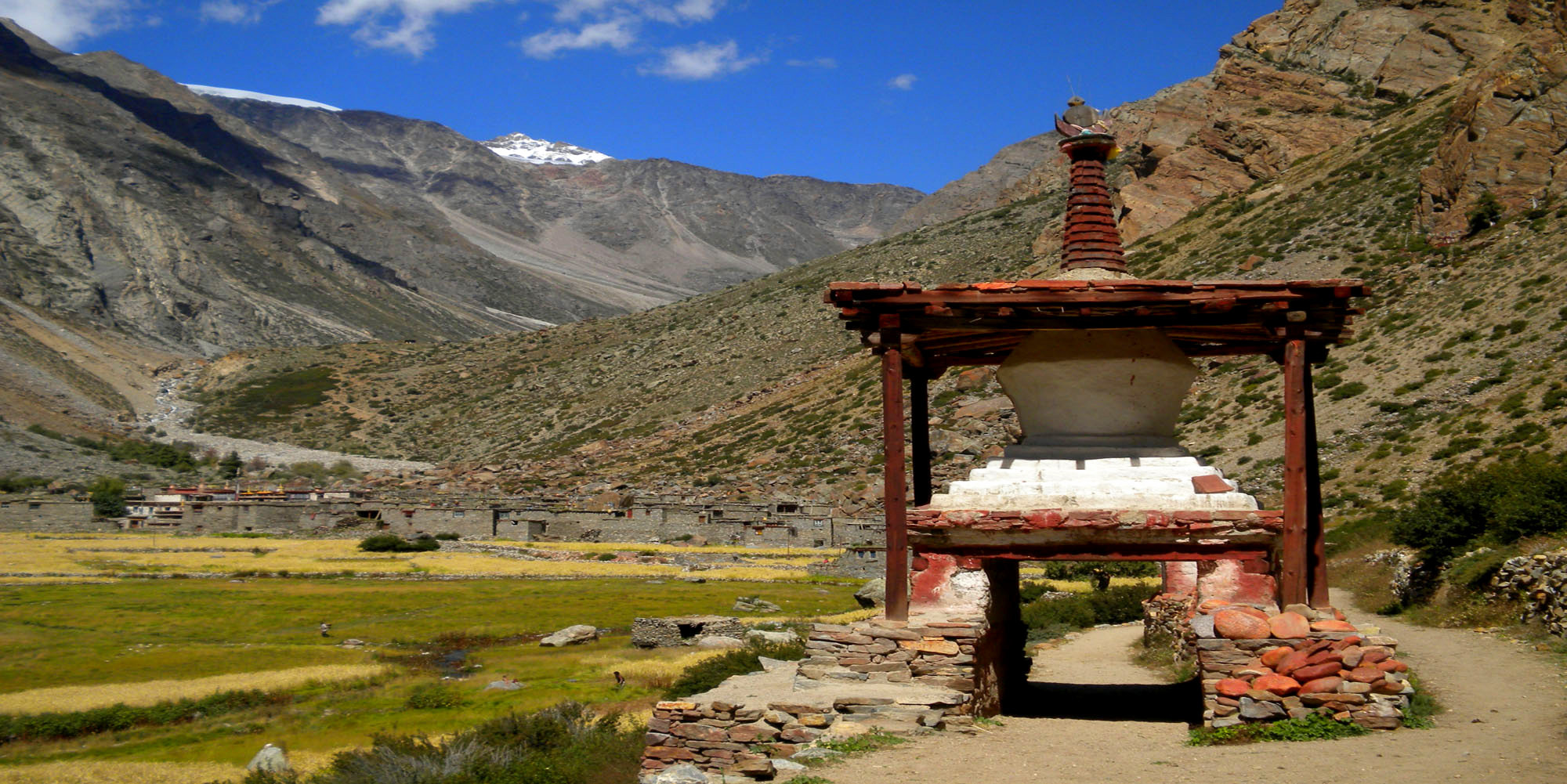
-
Geographic Features: Limi Valley is characterized by its rugged terrain, which includes rolling hills, stark cliffs, and wide, arid plains that resemble the Tibetan plateau. The valley is bordered by high mountain peaks, some of which remain snow-covered throughout the year, contributing to the region’s dramatic and imposing landscape.
-
Cultural Heritage: The residents of Limi Valley are predominantly Tibetan Buddhists, and their lifestyle, language, and customs are closely aligned with those of Tibet. The valley is dotted with ancient monasteries, chortens, and prayer walls that are integral to the daily lives of the local people. Among these, the monasteries of Til, Halji, and Jang are particularly significant, both spiritually and historically, featuring exquisite murals and artifacts that date back hundreds of years.
-
Biodiversity and Natural Environment: Limi Valley falls within the Humla district, an area known for its rich biodiversity. Despite the harsh climatic conditions, the region supports a variety of wildlife, including the elusive snow leopard, blue sheep, and Himalayan wolf. The valley's remote location and low human population density have helped preserve its natural ecosystems, making it an ideal place for nature lovers and conservationists.
-
Trekking Experience: Trekking to Limi Valley is challenging due to its remote location and the lack of developed infrastructure. The journey typically involves multiple days of walking in conditions that can range from dry and cold to occasionally wet and muddy, especially during the monsoon season. However, for those who undertake it, the trek offers unparalleled rewards: breathtaking views, serene landscapes, and the chance to witness a culture that has had little contact with the modern world.
-
Sustainable Travel and Conservation: Tourism in Limi Valley is still in its nascent stages, and there is a strong emphasis on sustainable practices to ensure that travel to the region does not disrupt its ecological balance or cultural integrity. Visitors are encouraged to follow ethical trekking practices, including respecting local customs, minimizing waste, and contributing to the local economy in a manner that supports conservation efforts.
Visiting Limi Valley is more than just a trek; it's an expedition into a world that defies time. With its pristine natural beauty, rich cultural tapestry, and the welcoming hearts of its people, Limi Valley offers a unique and unforgettable adventure for those looking to explore the truly untouched corners of the Himalayas.
Tips for Nepal's Unknown Regions: Less Explored Places
Exploring Nepal's less known regions offers an adventurous and deeply cultural experience, but it also presents unique challenges. Here are some essential tips for travelers planning to venture into these less explored places:
-
Research Thoroughly: Before setting out, thoroughly research the specific region you plan to visit. Understand its geography, culture, climate, and any specific travel restrictions or requirements. This includes knowledge about permits needed, as many remote areas in Nepal require special permissions.
-
Hire Local Guides: Employing a local guide is not only beneficial for navigation and communication but also enriches your trekking experience. Local guides provide insights into the cultural and historical contexts of the areas you explore and ensure that your journey adheres to local norms and traditions.
-
Be Prepared for Basic Conditions: Facilities in Nepal's remote areas can be basic, especially when it comes to accommodations and toilets. Prepare to stay in homestays or guesthouses with minimal amenities. Carrying some camping gear might be advisable in areas where accommodations are scarce.
-
Pack Appropriately: The weather in mountainous regions can be unpredictable. Pack layers of clothing to accommodate varying temperatures and a sturdy pair of trekking boots. Don’t forget essentials like a first-aid kit, water purification tablets, and energy snacks. Also, include items for environmental protection such as sunscreen, hats, and sunglasses.
-
Respect Local Customs: Remote communities may adhere strictly to their cultural norms and traditions. Show respect by dressing modestly, asking permission before taking photographs, and observing local etiquette. Learning a few phrases in the local language can also go a long way in showing respect and building rapport with the community.
-
Plan for Limited Connectivity: Many of Nepal's less explored regions have limited to no internet or mobile connectivity. Prepare to be off the grid for the duration of your visit. Inform someone of your itinerary and expected return date before you leave for your trek.
-
Travel Sustainably: Preserve the natural environment and support local economies. Avoid leaving any trash behind, use water sparingly, and where possible, choose eco-friendly products. Opting for local goods and services benefits the community and enhances your travel experience.
-
Stay Healthy: Altitude sickness is a real concern in high-altitude areas. Acclimatize properly, stay hydrated, and monitor your health. Be aware of the symptoms of altitude sickness and have a plan in case you need to descend or seek medical assistance.
-
Manage Your Expectations: Traveling to remote areas can be challenging and may not offer the comfort and convenience found in more developed tourist spots. Embrace the simplicity and authenticity of your experience, which is a significant part of the adventure.
-
Secure Comprehensive Travel Insurance: Ensure your travel insurance covers high-altitude trekking and medical evacuation, as getting medical help in remote areas can be complicated and expensive.
By following these tips, you can have a safer and more enriching experience exploring the hidden treasures of Nepal's less known regions.
Best Time to Visit Nepal's Unknown Regions: Less Explored Places
The best time to visit Nepal's unknown regions and less explored places largely depends on the specific area and the activities planned, but generally, the optimal periods are during the pre-monsoon spring months and the post-monsoon autumn months. Here's a breakdown of these seasons:
-
Spring (March to May): Spring is one of the best times to visit Nepal's remote regions. The weather is generally warm and stable, and the skies are clear, offering excellent views of the Himalayas. This is also the time when the landscapes burst into color with blooming flowers, particularly rhododendrons, which are prolific in many parts of Nepal. The temperature is comfortable for trekking, and the trails are less muddy than during the monsoon season.
-
Autumn (September to November): Autumn is considered the peak trekking season in Nepal for good reason. The monsoon rains have cleared the dust from the air, resulting in crystal-clear skies and spectacular mountain views. The weather is cool but not yet cold, especially at higher altitudes, making it ideal for trekking. This is also a culturally vibrant time to visit, coinciding with major Nepali festivals like Dashain and Tihar, which may offer unique cultural insights and experiences in the less explored regions.
Off-Peak Seasons
-
Winter (December to February): Winter can be a challenging time to visit the higher altitude areas due to heavy snow and cold temperatures, which might make some passes impassable. However, lower regions can still be quite accessible and offer the beauty of snow-capped landscapes with fewer tourists around.
-
Monsoon (June to August): Trekking in remote areas during the monsoon can be difficult due to heavy rains, slippery trails, and potential leeches. However, the rain washes the landscape into a vibrant green, waterfalls are at their most spectacular, and there are fewer tourists. Some areas like Upper Mustang and Dolpo are in rain-shadow regions, making them suitable destinations even during monsoon as they receive significantly less rainfall.
By choosing the right time based on both weather conditions and personal interests, visitors can fully enjoy the natural beauty and cultural richness of Nepal's less explored places.
Exploring Nepal's unknown regions offers a unique adventure into some of the most pristine and culturally rich areas of the Himalayas. These less explored places provide breathtaking landscapes and deep cultural immersion into communities that maintain ancient traditions. Whether it’s the remote terrains of Dolpo, the serene expanses of Rara Lake, or the mystical valleys of Tsum, each region offers a distinct and memorable experience. By visiting these areas, travelers not only fulfill their wanderlust but also contribute to these regions' sustainable development, helping preserve their natural and cultural heritage for future generations. In essence, lesser-known areas of Nepal offer a profound journey that enriches the soul and leaves lasting impressions.
FAQs for Nepal's Unknown Regions: Less Explored Places
Q: What are the best unknown regions in Nepal for trekking?
A: The best lesser-known trekking regions in Nepal include Dolpo, Tsum Valley, Manaslu Circuit, Upper Mustang, Limi Valley, and Kanchenjunga Base Camp. Each offers unique landscapes and cultural experiences.
Q: Do I need special permits to trek in these regions?
A: Yes, many of Nepal's lesser-known regions are controlled areas and require special permits. These include Manaslu, Upper Mustang, Dolpo, and Kanchenjunga. Permits help regulate tourism to protect the environment and local cultures.
Q: What is the best time to visit these remote regions?
A: The optimal times to visit most remote regions in Nepal are during the pre-monsoon spring months (March to May) and post-monsoon autumn months (September to November). These periods typically feature stable weather and clear skies.
Q: Are these regions suitable for beginner trekkers?
A: While some regions like Tsum Valley and Upper Mustang are accessible for trekkers of all levels, others like Dolpo and Kanchenjunga are more suited for experienced trekkers due to their challenging terrain and higher altitudes.
Q: What should I pack for trekking in remote Nepalese regions?
A: Essential items include layered clothing, sturdy trekking boots, a first-aid kit, water purification tablets, high-energy snacks, and navigational tools. Also, consider packing cultural sensitivity items like modest clothing and small gifts for local hosts.
Q: How can I ensure I respect local cultures during my visit?
A: Learn about local customs and religious practices before you arrive. Dress modestly, ask permission before taking photographs, and avoid public displays of affection. Always follow your guide's advice on local etiquette.
Q: What are the lodging options in these areas?
A: Accommodations in remote areas can vary from homestays and local guesthouses to camping, depending on the region. Facilities are typically basic, reflecting the local living standards.
Q: Is it safe to trek in these regions?
A: While generally safe, trekking in remote areas comes with risks such as unpredictable weather and limited emergency services. Hiring a local guide, trekking in a group, and having a well-planned itinerary are crucial safety measures.
Q: Can I use my mobile phone in these areas?
A: Connectivity can be sparse or non-existent in remote regions. It's advisable to inform someone of your itinerary beforehand and consider renting a satellite phone for emergencies.
Q: What are the conservation efforts in place?
A: Many of these regions are protected areas or national parks with specific rules designed to protect their ecosystems. As a visitor, follow the principles of Leave No Trace, support local conservation efforts by paying entry fees, and use local services that promote sustainable practices.
For the Nepal tour, please click here.
If you are looking for different kinds of Nepal Tours or Trekking Packages, feel free to contact us.
